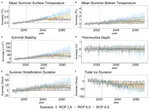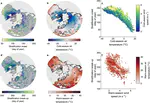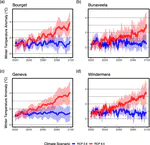 Example output data in the ISIMIP2b Lake Sector (Golub et al., 2022)
Example output data in the ISIMIP2b Lake Sector (Golub et al., 2022)
GLEON project page.
Tadhg N. Moore
Senior Lake Scientist
My research interests include environmental data analysis, lake modelling and water education.
Publications
Lake thermal dynamics have been altered around the world as a result of climate change, necessitating a predictive understanding of how climate will continue to alter lakes in the future as well as the associated uncertainty in these predictions. We found that the dominant source of uncertainty varied among the thermal metrics, as thermal metrics associated with the surface waters (surface water temperature, total ice duration) were driven primarily by climate model selection uncertainty, while metrics associated with deeper depths (bottom water temperature, stratification duration) were dominated by lake model selection uncertainty.
Jacob H. Wynne,
Whitney M. Woelmer,
Tadhg N. Moore,
R. Quinn Thomas,
Kathleen C. Weathers,
Cayelan C. Carey
Lake thermal dynamics have been altered around the world as a result of climate change, necessitating a predictive understanding of how climate will continue to alter lakes in the future as well as the associated uncertainty in these predictions. We found that the dominant source of uncertainty varied among the thermal metrics, as thermal metrics associated with the surface waters (surface water temperature, total ice duration) were driven primarily by climate model selection uncertainty, while metrics associated with deeper depths (bottom water temperature, stratification duration) were dominated by lake model selection uncertainty.
Jacob H. Wynne,
Whitney M. Woelmer,
Tadhg N. Moore,
R. Quinn Thomas,
Kathleen C. Weathers,
Cayelan C. Carey
Five lake models forced by four different climate model projections are used to simulate historic and future change in lake evaporation for Lake Kinneret (Israel). There were considerable differences in simulated evaporation rates among the models, with the annual average evaporation rates varying between 1232 mm year-1 and 2608 mm year-1 during the historic period (1901-2005). By the end of the 21st century (2070-2099), annual average evaporation rates would increase by 9-22% under RCPs 2.6-8.5. Our projections suggest that the water balance of Lake Kinneret could experience a deficit of 14-40% this century.
Sofia La Fuente,
Eleanor Jennings,
Gideon Gal,
Georgiy Kirillin,
Tom Shatwell,
Robert Ladwig,
Tadhg N. Moore,
Raoul-Marie Couture,
Marianne Côté,
C. Love Råman Vinnå,
R. Iestyn Woolway
Methane is typically produced in lake sediments, with the rate of methane production being strongly temperature dependent. Future warming of bottom waters will likely result in an increase in methane production rates of 13%–40% by the end of the century, with many low-latitude lakes experiencing an increase of up to 17 times the historical (1970–1999) global average under RCP 8.5.
Joachim Jansen,
Richard Iestyn Woolway,
Benjamin M. Kraemer,
Clément Albergel,
David Bastviken,
Gesa A. Weyhenmeyer,
Rafael Marcé,
Sapna Sharma,
Sebastian Sobek,
Lars J. Tranvik,
Marjorie Perroud,
Malgorzata Golub,
Tadhg N. Moore,
Love Råman Vinnå,
Sofia La Fuente,
Luke Grant,
Don C. Pierson,
Wim Thiery,
Eleanor Jennings
Under the high-greenhouse-gas-emission scenario, stratification will begin 22.0 ± 7.0 days earlier and end 11.3 ± 4.7 days later by the end of this century. It is very likely that this 33.3 ± 11.7 day prolongation in stratification will accelerate lake deoxygenation with subsequent effects on nutrient mineralization and phosphorus release from lake sediments. Further misalignment of lifecycle events, with possible irreversible changes for lake ecosystems, is also likely.
R. Iestyn Woolway,
Sapna Sharma,
Gesa A. Weyhenmeyer,
Andrey Debolskiy,
Malgorzata Golub,
Daniel Mercado-Bettín,
Marjorie Perroud,
Victor Stepanenko,
Zeli Tan,
Luke Grant,
Robert Ladwig,
Jorrit Mesman,
Tadhg N. Moore,
Tom Shatwell,
Inne Vanderkelen,
Jay A. Austin,
Curtis L. DeGasperi,
Martin Dokulil,
Sofia La Fuente,
Eleanor B. Mackay,
S. Geoffrey Schladow,
Shohei Watanabe,
Rafael Marcé,
Don C. Pierson,
Wim Thiery,
Eleanor Jennings
We combined lake temperature observations, a 1-D hydrodynamic model, and a multi-decadal climate reanalysis to show coherence in warming winter water temperatures in four European charr lakes. We suggest that the perpetuating winter warming trends shown here will imperil the future status of these lakes as charr refugia and generally do not augur well for the fate of coldwater-adapted lake fish in a warming climate.
Seán Kelly,
Tadhg N. Moore,
Elvira de Eyto,
Mary Dillane,
Chloé Goulon,
Jean Guillard,
Emilien Lasne,
Phil McGinnity,
Russell Poole,
Ian J. Winfield,
R. Iestyn Woolway,
Eleanor Jennings





